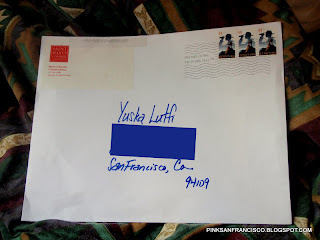Saturday 30 April 2011
sylvia and assia
Sunday 24 April 2011
russell brand is funny? how?
 I had the absolute misfortune of watching Arthur a while ago. The movie was not just uninspiring, nay, it was painful to watch. I cringed everytime Arthur Bach (Russell Brand's character) delivered a line, and he's the main actor (a.k.a the one with the most lines).
I had the absolute misfortune of watching Arthur a while ago. The movie was not just uninspiring, nay, it was painful to watch. I cringed everytime Arthur Bach (Russell Brand's character) delivered a line, and he's the main actor (a.k.a the one with the most lines). Wednesday 20 April 2011
sylvia plath
I was web surfing in the middle of the night as usual, when I stumbled upon a web link: Top 10 Famous People who Committed Suicide. One of them was the poet Sylvia Plath. At that time, I stored Plath’s name in my memory, but did not do further studies on her or her work. The next day, when I was in a bookstore, my feet took me to the English Literature section and I found The Bell Jar, her one and only novel, a semi-autobiography.
Needless to say, I could not put it down. It grew so much on me that I became irrationally depressed. The only release I could get was by painting my eyes. I had always been drawn to dark colors. However, it was only after reading The Bell Jar that I felt the need to start wearing dark eye make-up. And so, my fascination with Plath began.
Sylvia Plath was born on October 27, 1932 in Massachusetts. She studied at Smith College and Newnham College, Cambridge and later received acclaim as a professional poet and writer. Her genre of poetry can be classified as confessional poetry. The two best known collections of her poetry are The Colossus and Other Poems and Ariel. I own Ariel and I have to admit that I am greatly influenced by her writing style.
She married fellow poet Ted Hughes in 1956 and had two children with him, Frieda and Nicholas. Frieda later edited a new edition of the Ariel collection, feeling that her father’s version of Ariel did not completely show Sylvia Plath’s voice.
Her marriage to Hughes crumbled when Hughes was caught having an affair with their friend, the socialite Assia Wevill. When I learned about this, I completely identified myself with her as I have had a similar experience. The affair led to subsequent divorce, and, combined with a long struggle with depression (she was diagnosed with Bipolar Syndrome), made her to commit suicide.
At approximately 4:30 AM on February 11, 1963, Plath placed her head in the oven with the gas turned on. She died of carbon monoxide poisoning. Beforehand, she had sealed the rooms between her and her sleeping children with wet towels and cloths. Sylvia Plath was the first poet to win the Pulitzer Price posthumously. She won the award for her work The Collected Poems.
I am completely aware of Sylvia Plath’s dark influence. And yet I feel the strong need to know her personally and to learn from her, especially her sense of discipline when it comes to writing. She carried her Thesaurus around, preferring it to the Bible. Whenever she got home, she would make detailed descriptions of the places she visited and the people she met. These descriptions became the basis of her work. It is most unfortunate that people began to realize her talent after her death. Like Joni Mitchell said, “You don’t know what you’ve got till it’s gone.”
guess what came in the mail
 I just got accepted at St. Mary's College of California for the MFA program in Creative Writing in Fiction.
I just got accepted at St. Mary's College of California for the MFA program in Creative Writing in Fiction. Wednesday 13 April 2011
amy tan on creativity
In a nutshell, Tan summed creativity as the sense of inability to repress looking at anything in life. As a writer, it is important to be able to receive inspiration from everything. She also stated that creative people are multidimensional, able to see through multiple layers of an issue. This makes sense since the ability to see and analyze many layers becomes the backbone of a rich and vibrant writing. In her presentation, she talked about how she received her inspiration, an experience that she described as ambiguous. She needs moral ambiguity to write stories. This moral ambiguity creates a sequence of responses and intentions, the fuel of her stories.
I am still in the middle of reading The Joy Luck Club, the first of her novels. The Joy Luck Club explores mother-daughter relationships of four women and each of their mothers. More specifically, Chinese mothers who went to the United States, seeking for a better life and future. All of the women had a somewhat murky past. They found each other through a Mah Jong club that they named “Joy Luck”. Friendship bloomed in that club, as well as competition. Being very close to my mother, needless to say, there were instances when I found myself crying on the bus while reading the book. The book itself is almost autobiographical to Tan’s life. Facets of her and her mother’s history serve as the basis of the stories in The Joy Luck Club.
Tan’s idea of creativity is relatable, at least to me. Creativity comes to me when I have an enquiry, when I begin to question aspects of life, and in some cases, of death. I sometimes make up my own answers and assumptions to some questions, as for the rest, I do research. The research depends on the time and resources. If I have enough time and resources, I’ll do a thorough analysis. If I don’t, I will have to be satisfied with what I have and go on with my life. Perhaps along the way, I will get more answers.
Nonetheless, these questions, including the what-ifs have become the source of my inspiration. I create a dialog within my head, with hypotheses and more questions. I will have these conversations until I’m ready to sleep. Usually they calm me down because I’m assured I will have enough to write.
Amy Tan believes that one characteristic of a good writer is that he or she never stops thinking. If that is the case, then I believe I have the making of a good writer.
Monday 11 April 2011
my love affair with spongebob squarepants
Sunday 10 April 2011
the san francisco maritime museum
The walls of the museum boast the murals by Hilaire Hiller. The mural, painted in 1938, was restored in 2010. The SF Maritime Museum has four floors: the first floor is used as senior center, the second (ground) floor is for exhibition, while the third and fourth floors are currently being restored. Due to budget cuts, these upper floors will finish their restorations in 2012. The SF Maritime Museum’s funds come primarily from the National Parks Services and admission into the museum is free, but it never hurts to put a little money inside the donation box on your way out.
I know the pictures here don't do the museum justice, so I'll try to take more photos on Monday.
